Report on Business Economics: Tobacco Market Analysis and Policies
VerifiedAdded on 2022/11/30
|10
|2697
|351
Report
AI Summary
This report provides a comprehensive analysis of the business economics of the tobacco market, examining both microeconomic and macroeconomic factors. It begins with an overview of the tobacco market, highlighting the impact of consumer weakness and the dominance of a few transnational corporations. The report delves into market failures, particularly knowledge asymmetry and environmental costs, and explores the factors of production, including labor markets and their stickiness effects. It also investigates financial markets and their importance in the context of the tobacco industry. From a macroeconomic perspective, the report discusses government economic policies, including monetary and fiscal measures, supply-side and demand-side policies, inflation, and international business. It analyzes the implications of these policies on economic growth and balance of payments, offering a detailed understanding of the complex economic forces at play in the tobacco market. The report also emphasizes the role of regulation, taxation, and international trade in shaping the industry's landscape and its impact on public health.
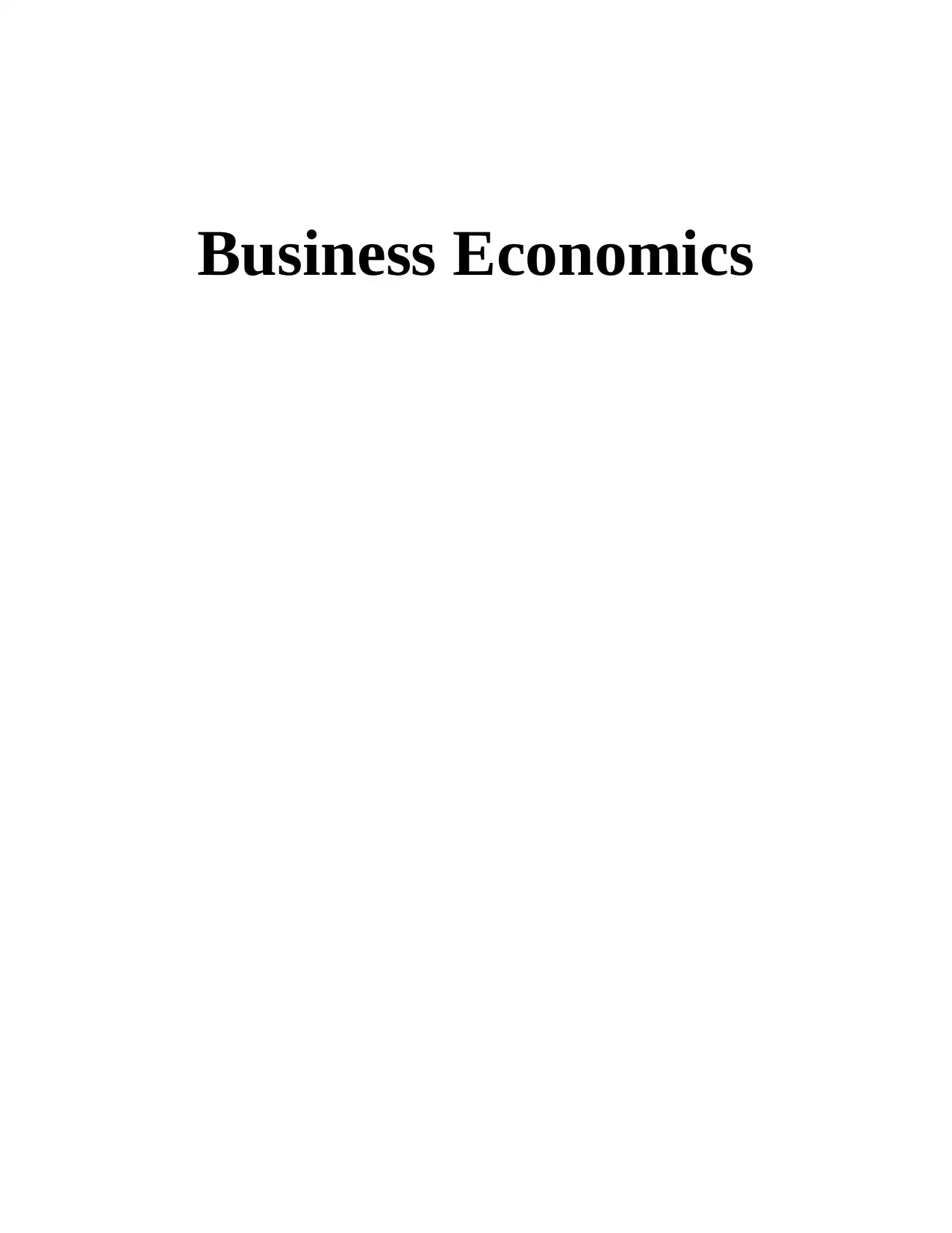
Business Economics
Paraphrase This Document
Need a fresh take? Get an instant paraphrase of this document with our AI Paraphraser


Contents
INTRODUCTION...........................................................................................................................................3
A. Overview of the case study.....................................................................................................................3
B. Micro economics.....................................................................................................................................3
Market failure and imperfections.............................................................................................................3
Market and factors of production.............................................................................................................4
Labor market and its stickiness effect on production...............................................................................4
Financial market and its importance........................................................................................................5
C. Macroeconomics.....................................................................................................................................5
Government economic policy..................................................................................................................5
Supply side and demand side policies......................................................................................................6
Inflation and price stability......................................................................................................................6
International business and trade...............................................................................................................7
Economic growth and balance of payment..............................................................................................7
REFERENCES................................................................................................................................................9
INTRODUCTION...........................................................................................................................................3
A. Overview of the case study.....................................................................................................................3
B. Micro economics.....................................................................................................................................3
Market failure and imperfections.............................................................................................................3
Market and factors of production.............................................................................................................4
Labor market and its stickiness effect on production...............................................................................4
Financial market and its importance........................................................................................................5
C. Macroeconomics.....................................................................................................................................5
Government economic policy..................................................................................................................5
Supply side and demand side policies......................................................................................................6
Inflation and price stability......................................................................................................................6
International business and trade...............................................................................................................7
Economic growth and balance of payment..............................................................................................7
REFERENCES................................................................................................................................................9
⊘ This is a preview!⊘
Do you want full access?
Subscribe today to unlock all pages.

Trusted by 1+ million students worldwide

INTRODUCTION
Economics is basically an analysis of resource distribution under unique conditions, much of
which is bound by the ambitious expectation that the object of study is a reasonable individual
seeking to increase its general well-being. The aim of learning economics is to get a better
understanding of the decision-making process that goes into allocating scarce capital to meet
ever-increasing requirements (Stevenson, Kuratko and Eutsler, 2019).
A. Overview of the case study
Tobacco markets, which are largely controlled by smokers, must be regulated. It
demonstrates how consumer weakness in the form of economic power, in combination with
some well and required tobacco protection measures such as taxes and advertisement controls,
has resulted in tobacco producers gaining significant buying power and revenues. In doing just
that, it highlights an often-overlooked aspect of tobacco control: steady rises in individual taxes
favor cigarette producers by allowing them to raise rates and therefore revenues, explaining why
company profits remain high amid declining tobacco sales. Then it considers how to solve the
issue, suggesting as a remedy a scheme of price limit legislation, which will enable policymakers
to retain and extend tobacco preventive measures while avoiding adverse effects by reducing
cigarette producers' rates but maybe not the value that customers face at major retailers (Rahman,
Sobhan and Islam, 2019).
B. Micro economics
Market failure and imperfections
The four major factors of market failure are knowledge failure or asymmetry,
environmental costs like the externalized costs placed on others by the production and use of
alcohol, the distribution of social infrastructure, and market control, according to traditional
economic theory. The existence of two of these (data failure and environmental impacts) in a
tobacco industry has been already established, and they will not be discussed further here.
Instead, we'll see how consumer dominance works as well. Through several acquisitions and
mergers, the couple of large tobacco transnational corporations have decreased to just four,
which now dominate the global tobacco industry even outside China. Philip Morris International,
Economics is basically an analysis of resource distribution under unique conditions, much of
which is bound by the ambitious expectation that the object of study is a reasonable individual
seeking to increase its general well-being. The aim of learning economics is to get a better
understanding of the decision-making process that goes into allocating scarce capital to meet
ever-increasing requirements (Stevenson, Kuratko and Eutsler, 2019).
A. Overview of the case study
Tobacco markets, which are largely controlled by smokers, must be regulated. It
demonstrates how consumer weakness in the form of economic power, in combination with
some well and required tobacco protection measures such as taxes and advertisement controls,
has resulted in tobacco producers gaining significant buying power and revenues. In doing just
that, it highlights an often-overlooked aspect of tobacco control: steady rises in individual taxes
favor cigarette producers by allowing them to raise rates and therefore revenues, explaining why
company profits remain high amid declining tobacco sales. Then it considers how to solve the
issue, suggesting as a remedy a scheme of price limit legislation, which will enable policymakers
to retain and extend tobacco preventive measures while avoiding adverse effects by reducing
cigarette producers' rates but maybe not the value that customers face at major retailers (Rahman,
Sobhan and Islam, 2019).
B. Micro economics
Market failure and imperfections
The four major factors of market failure are knowledge failure or asymmetry,
environmental costs like the externalized costs placed on others by the production and use of
alcohol, the distribution of social infrastructure, and market control, according to traditional
economic theory. The existence of two of these (data failure and environmental impacts) in a
tobacco industry has been already established, and they will not be discussed further here.
Instead, we'll see how consumer dominance works as well. Through several acquisitions and
mergers, the couple of large tobacco transnational corporations have decreased to just four,
which now dominate the global tobacco industry even outside China. Philip Morris International,
Paraphrase This Document
Need a fresh take? Get an instant paraphrase of this document with our AI Paraphraser
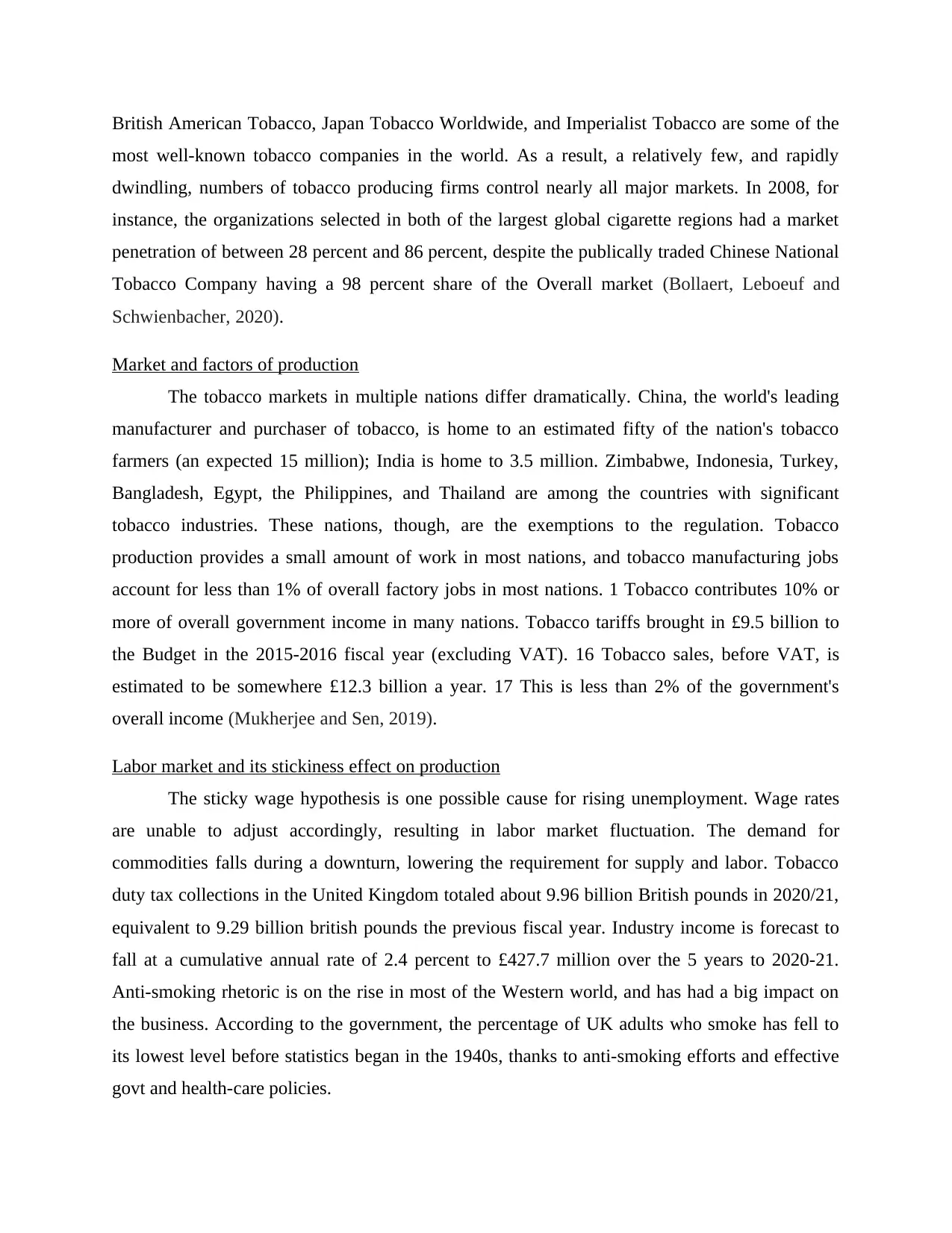
British American Tobacco, Japan Tobacco Worldwide, and Imperialist Tobacco are some of the
most well-known tobacco companies in the world. As a result, a relatively few, and rapidly
dwindling, numbers of tobacco producing firms control nearly all major markets. In 2008, for
instance, the organizations selected in both of the largest global cigarette regions had a market
penetration of between 28 percent and 86 percent, despite the publically traded Chinese National
Tobacco Company having a 98 percent share of the Overall market (Bollaert, Leboeuf and
Schwienbacher, 2020).
Market and factors of production
The tobacco markets in multiple nations differ dramatically. China, the world's leading
manufacturer and purchaser of tobacco, is home to an estimated fifty of the nation's tobacco
farmers (an expected 15 million); India is home to 3.5 million. Zimbabwe, Indonesia, Turkey,
Bangladesh, Egypt, the Philippines, and Thailand are among the countries with significant
tobacco industries. These nations, though, are the exemptions to the regulation. Tobacco
production provides a small amount of work in most nations, and tobacco manufacturing jobs
account for less than 1% of overall factory jobs in most nations. 1 Tobacco contributes 10% or
more of overall government income in many nations. Tobacco tariffs brought in £9.5 billion to
the Budget in the 2015-2016 fiscal year (excluding VAT). 16 Tobacco sales, before VAT, is
estimated to be somewhere £12.3 billion a year. 17 This is less than 2% of the government's
overall income (Mukherjee and Sen, 2019).
Labor market and its stickiness effect on production
The sticky wage hypothesis is one possible cause for rising unemployment. Wage rates
are unable to adjust accordingly, resulting in labor market fluctuation. The demand for
commodities falls during a downturn, lowering the requirement for supply and labor. Tobacco
duty tax collections in the United Kingdom totaled about 9.96 billion British pounds in 2020/21,
equivalent to 9.29 billion british pounds the previous fiscal year. Industry income is forecast to
fall at a cumulative annual rate of 2.4 percent to £427.7 million over the 5 years to 2020-21.
Anti-smoking rhetoric is on the rise in most of the Western world, and has had a big impact on
the business. According to the government, the percentage of UK adults who smoke has fell to
its lowest level before statistics began in the 1940s, thanks to anti-smoking efforts and effective
govt and health-care policies.
most well-known tobacco companies in the world. As a result, a relatively few, and rapidly
dwindling, numbers of tobacco producing firms control nearly all major markets. In 2008, for
instance, the organizations selected in both of the largest global cigarette regions had a market
penetration of between 28 percent and 86 percent, despite the publically traded Chinese National
Tobacco Company having a 98 percent share of the Overall market (Bollaert, Leboeuf and
Schwienbacher, 2020).
Market and factors of production
The tobacco markets in multiple nations differ dramatically. China, the world's leading
manufacturer and purchaser of tobacco, is home to an estimated fifty of the nation's tobacco
farmers (an expected 15 million); India is home to 3.5 million. Zimbabwe, Indonesia, Turkey,
Bangladesh, Egypt, the Philippines, and Thailand are among the countries with significant
tobacco industries. These nations, though, are the exemptions to the regulation. Tobacco
production provides a small amount of work in most nations, and tobacco manufacturing jobs
account for less than 1% of overall factory jobs in most nations. 1 Tobacco contributes 10% or
more of overall government income in many nations. Tobacco tariffs brought in £9.5 billion to
the Budget in the 2015-2016 fiscal year (excluding VAT). 16 Tobacco sales, before VAT, is
estimated to be somewhere £12.3 billion a year. 17 This is less than 2% of the government's
overall income (Mukherjee and Sen, 2019).
Labor market and its stickiness effect on production
The sticky wage hypothesis is one possible cause for rising unemployment. Wage rates
are unable to adjust accordingly, resulting in labor market fluctuation. The demand for
commodities falls during a downturn, lowering the requirement for supply and labor. Tobacco
duty tax collections in the United Kingdom totaled about 9.96 billion British pounds in 2020/21,
equivalent to 9.29 billion british pounds the previous fiscal year. Industry income is forecast to
fall at a cumulative annual rate of 2.4 percent to £427.7 million over the 5 years to 2020-21.
Anti-smoking rhetoric is on the rise in most of the Western world, and has had a big impact on
the business. According to the government, the percentage of UK adults who smoke has fell to
its lowest level before statistics began in the 1940s, thanks to anti-smoking efforts and effective
govt and health-care policies.
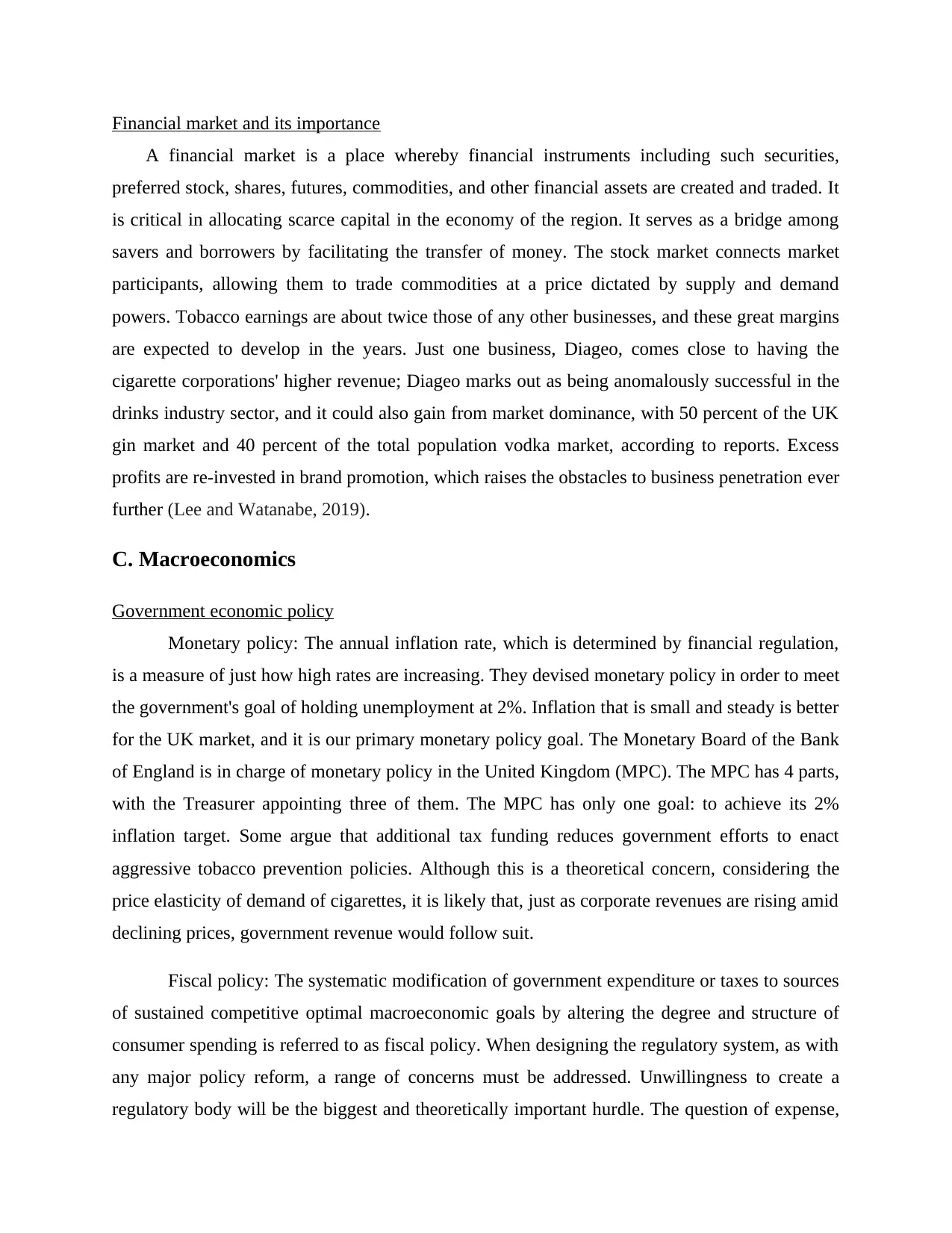
Financial market and its importance
A financial market is a place whereby financial instruments including such securities,
preferred stock, shares, futures, commodities, and other financial assets are created and traded. It
is critical in allocating scarce capital in the economy of the region. It serves as a bridge among
savers and borrowers by facilitating the transfer of money. The stock market connects market
participants, allowing them to trade commodities at a price dictated by supply and demand
powers. Tobacco earnings are about twice those of any other businesses, and these great margins
are expected to develop in the years. Just one business, Diageo, comes close to having the
cigarette corporations' higher revenue; Diageo marks out as being anomalously successful in the
drinks industry sector, and it could also gain from market dominance, with 50 percent of the UK
gin market and 40 percent of the total population vodka market, according to reports. Excess
profits are re-invested in brand promotion, which raises the obstacles to business penetration ever
further (Lee and Watanabe, 2019).
C. Macroeconomics
Government economic policy
Monetary policy: The annual inflation rate, which is determined by financial regulation,
is a measure of just how high rates are increasing. They devised monetary policy in order to meet
the government's goal of holding unemployment at 2%. Inflation that is small and steady is better
for the UK market, and it is our primary monetary policy goal. The Monetary Board of the Bank
of England is in charge of monetary policy in the United Kingdom (MPC). The MPC has 4 parts,
with the Treasurer appointing three of them. The MPC has only one goal: to achieve its 2%
inflation target. Some argue that additional tax funding reduces government efforts to enact
aggressive tobacco prevention policies. Although this is a theoretical concern, considering the
price elasticity of demand of cigarettes, it is likely that, just as corporate revenues are rising amid
declining prices, government revenue would follow suit.
Fiscal policy: The systematic modification of government expenditure or taxes to sources
of sustained competitive optimal macroeconomic goals by altering the degree and structure of
consumer spending is referred to as fiscal policy. When designing the regulatory system, as with
any major policy reform, a range of concerns must be addressed. Unwillingness to create a
regulatory body will be the biggest and theoretically important hurdle. The question of expense,
A financial market is a place whereby financial instruments including such securities,
preferred stock, shares, futures, commodities, and other financial assets are created and traded. It
is critical in allocating scarce capital in the economy of the region. It serves as a bridge among
savers and borrowers by facilitating the transfer of money. The stock market connects market
participants, allowing them to trade commodities at a price dictated by supply and demand
powers. Tobacco earnings are about twice those of any other businesses, and these great margins
are expected to develop in the years. Just one business, Diageo, comes close to having the
cigarette corporations' higher revenue; Diageo marks out as being anomalously successful in the
drinks industry sector, and it could also gain from market dominance, with 50 percent of the UK
gin market and 40 percent of the total population vodka market, according to reports. Excess
profits are re-invested in brand promotion, which raises the obstacles to business penetration ever
further (Lee and Watanabe, 2019).
C. Macroeconomics
Government economic policy
Monetary policy: The annual inflation rate, which is determined by financial regulation,
is a measure of just how high rates are increasing. They devised monetary policy in order to meet
the government's goal of holding unemployment at 2%. Inflation that is small and steady is better
for the UK market, and it is our primary monetary policy goal. The Monetary Board of the Bank
of England is in charge of monetary policy in the United Kingdom (MPC). The MPC has 4 parts,
with the Treasurer appointing three of them. The MPC has only one goal: to achieve its 2%
inflation target. Some argue that additional tax funding reduces government efforts to enact
aggressive tobacco prevention policies. Although this is a theoretical concern, considering the
price elasticity of demand of cigarettes, it is likely that, just as corporate revenues are rising amid
declining prices, government revenue would follow suit.
Fiscal policy: The systematic modification of government expenditure or taxes to sources
of sustained competitive optimal macroeconomic goals by altering the degree and structure of
consumer spending is referred to as fiscal policy. When designing the regulatory system, as with
any major policy reform, a range of concerns must be addressed. Unwillingness to create a
regulatory body will be the biggest and theoretically important hurdle. The question of expense,
⊘ This is a preview!⊘
Do you want full access?
Subscribe today to unlock all pages.

Trusted by 1+ million students worldwide
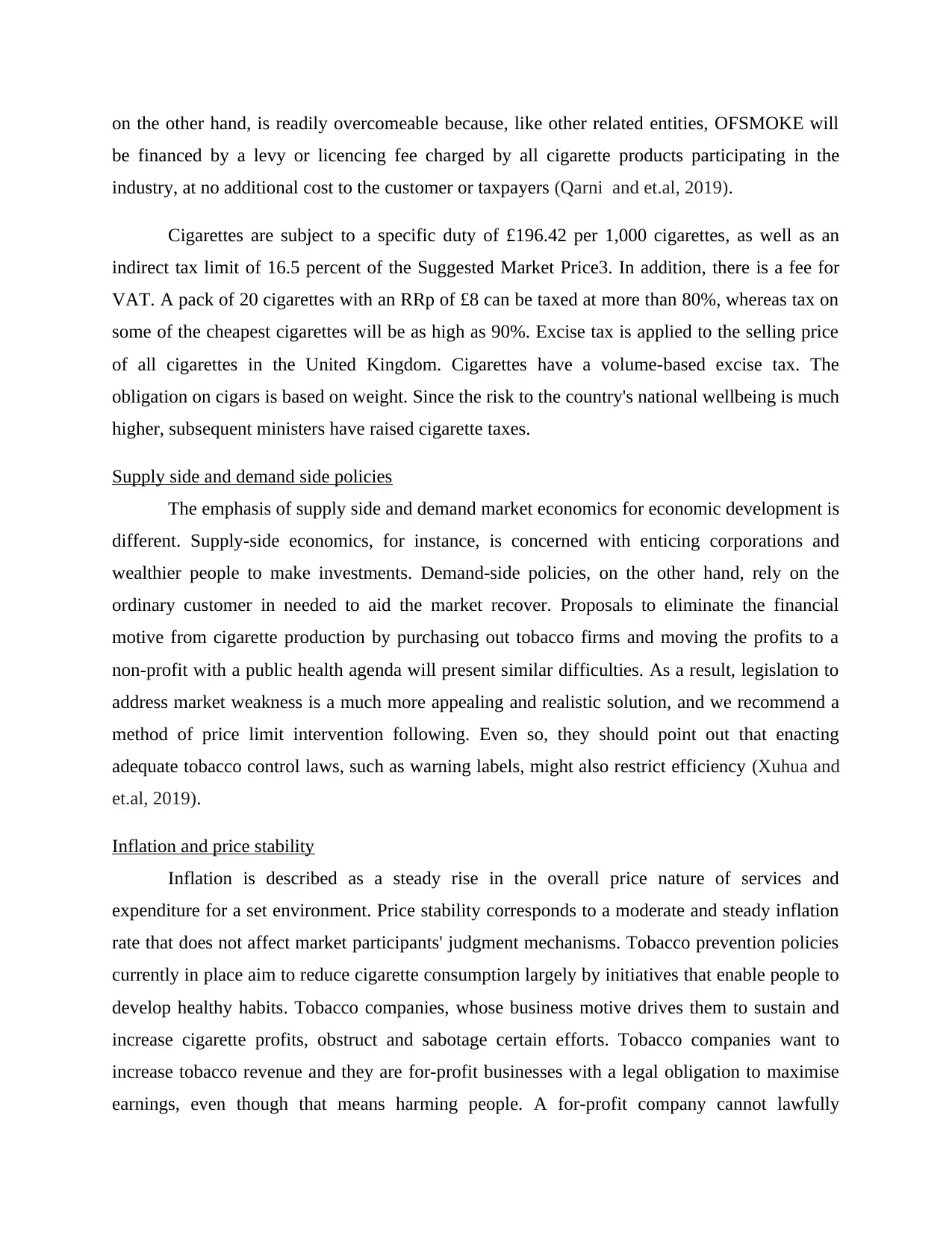
on the other hand, is readily overcomeable because, like other related entities, OFSMOKE will
be financed by a levy or licencing fee charged by all cigarette products participating in the
industry, at no additional cost to the customer or taxpayers (Qarni and et.al, 2019).
Cigarettes are subject to a specific duty of £196.42 per 1,000 cigarettes, as well as an
indirect tax limit of 16.5 percent of the Suggested Market Price3. In addition, there is a fee for
VAT. A pack of 20 cigarettes with an RRp of £8 can be taxed at more than 80%, whereas tax on
some of the cheapest cigarettes will be as high as 90%. Excise tax is applied to the selling price
of all cigarettes in the United Kingdom. Cigarettes have a volume-based excise tax. The
obligation on cigars is based on weight. Since the risk to the country's national wellbeing is much
higher, subsequent ministers have raised cigarette taxes.
Supply side and demand side policies
The emphasis of supply side and demand market economics for economic development is
different. Supply-side economics, for instance, is concerned with enticing corporations and
wealthier people to make investments. Demand-side policies, on the other hand, rely on the
ordinary customer in needed to aid the market recover. Proposals to eliminate the financial
motive from cigarette production by purchasing out tobacco firms and moving the profits to a
non-profit with a public health agenda will present similar difficulties. As a result, legislation to
address market weakness is a much more appealing and realistic solution, and we recommend a
method of price limit intervention following. Even so, they should point out that enacting
adequate tobacco control laws, such as warning labels, might also restrict efficiency (Xuhua and
et.al, 2019).
Inflation and price stability
Inflation is described as a steady rise in the overall price nature of services and
expenditure for a set environment. Price stability corresponds to a moderate and steady inflation
rate that does not affect market participants' judgment mechanisms. Tobacco prevention policies
currently in place aim to reduce cigarette consumption largely by initiatives that enable people to
develop healthy habits. Tobacco companies, whose business motive drives them to sustain and
increase cigarette profits, obstruct and sabotage certain efforts. Tobacco companies want to
increase tobacco revenue and they are for-profit businesses with a legal obligation to maximise
earnings, even though that means harming people. A for-profit company cannot lawfully
be financed by a levy or licencing fee charged by all cigarette products participating in the
industry, at no additional cost to the customer or taxpayers (Qarni and et.al, 2019).
Cigarettes are subject to a specific duty of £196.42 per 1,000 cigarettes, as well as an
indirect tax limit of 16.5 percent of the Suggested Market Price3. In addition, there is a fee for
VAT. A pack of 20 cigarettes with an RRp of £8 can be taxed at more than 80%, whereas tax on
some of the cheapest cigarettes will be as high as 90%. Excise tax is applied to the selling price
of all cigarettes in the United Kingdom. Cigarettes have a volume-based excise tax. The
obligation on cigars is based on weight. Since the risk to the country's national wellbeing is much
higher, subsequent ministers have raised cigarette taxes.
Supply side and demand side policies
The emphasis of supply side and demand market economics for economic development is
different. Supply-side economics, for instance, is concerned with enticing corporations and
wealthier people to make investments. Demand-side policies, on the other hand, rely on the
ordinary customer in needed to aid the market recover. Proposals to eliminate the financial
motive from cigarette production by purchasing out tobacco firms and moving the profits to a
non-profit with a public health agenda will present similar difficulties. As a result, legislation to
address market weakness is a much more appealing and realistic solution, and we recommend a
method of price limit intervention following. Even so, they should point out that enacting
adequate tobacco control laws, such as warning labels, might also restrict efficiency (Xuhua and
et.al, 2019).
Inflation and price stability
Inflation is described as a steady rise in the overall price nature of services and
expenditure for a set environment. Price stability corresponds to a moderate and steady inflation
rate that does not affect market participants' judgment mechanisms. Tobacco prevention policies
currently in place aim to reduce cigarette consumption largely by initiatives that enable people to
develop healthy habits. Tobacco companies, whose business motive drives them to sustain and
increase cigarette profits, obstruct and sabotage certain efforts. Tobacco companies want to
increase tobacco revenue and they are for-profit businesses with a legal obligation to maximise
earnings, even though that means harming people. A for-profit company cannot lawfully
Paraphrase This Document
Need a fresh take? Get an instant paraphrase of this document with our AI Paraphraser
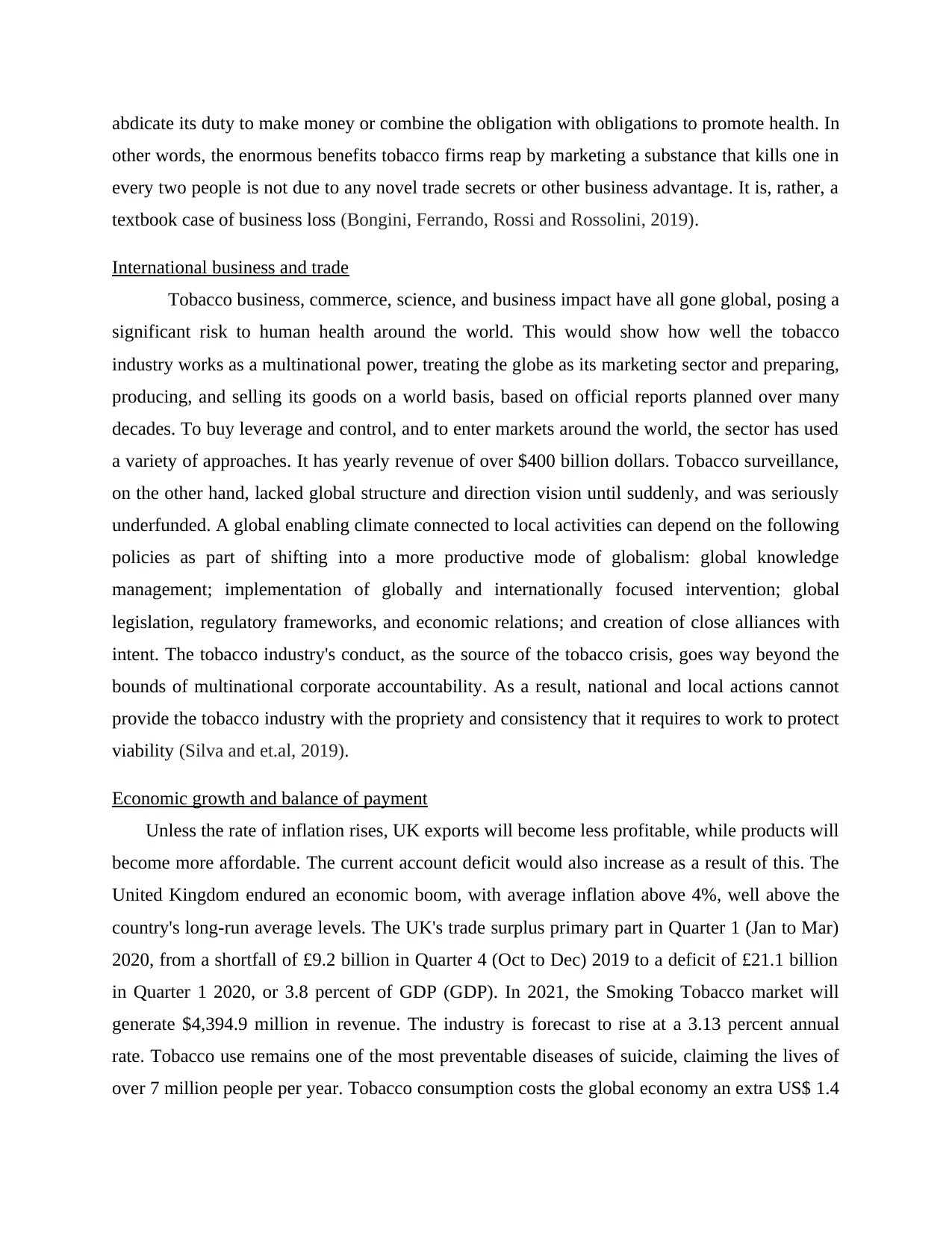
abdicate its duty to make money or combine the obligation with obligations to promote health. In
other words, the enormous benefits tobacco firms reap by marketing a substance that kills one in
every two people is not due to any novel trade secrets or other business advantage. It is, rather, a
textbook case of business loss (Bongini, Ferrando, Rossi and Rossolini, 2019).
International business and trade
Tobacco business, commerce, science, and business impact have all gone global, posing a
significant risk to human health around the world. This would show how well the tobacco
industry works as a multinational power, treating the globe as its marketing sector and preparing,
producing, and selling its goods on a world basis, based on official reports planned over many
decades. To buy leverage and control, and to enter markets around the world, the sector has used
a variety of approaches. It has yearly revenue of over $400 billion dollars. Tobacco surveillance,
on the other hand, lacked global structure and direction vision until suddenly, and was seriously
underfunded. A global enabling climate connected to local activities can depend on the following
policies as part of shifting into a more productive mode of globalism: global knowledge
management; implementation of globally and internationally focused intervention; global
legislation, regulatory frameworks, and economic relations; and creation of close alliances with
intent. The tobacco industry's conduct, as the source of the tobacco crisis, goes way beyond the
bounds of multinational corporate accountability. As a result, national and local actions cannot
provide the tobacco industry with the propriety and consistency that it requires to work to protect
viability (Silva and et.al, 2019).
Economic growth and balance of payment
Unless the rate of inflation rises, UK exports will become less profitable, while products will
become more affordable. The current account deficit would also increase as a result of this. The
United Kingdom endured an economic boom, with average inflation above 4%, well above the
country's long-run average levels. The UK's trade surplus primary part in Quarter 1 (Jan to Mar)
2020, from a shortfall of £9.2 billion in Quarter 4 (Oct to Dec) 2019 to a deficit of £21.1 billion
in Quarter 1 2020, or 3.8 percent of GDP (GDP). In 2021, the Smoking Tobacco market will
generate $4,394.9 million in revenue. The industry is forecast to rise at a 3.13 percent annual
rate. Tobacco use remains one of the most preventable diseases of suicide, claiming the lives of
over 7 million people per year. Tobacco consumption costs the global economy an extra US$ 1.4
other words, the enormous benefits tobacco firms reap by marketing a substance that kills one in
every two people is not due to any novel trade secrets or other business advantage. It is, rather, a
textbook case of business loss (Bongini, Ferrando, Rossi and Rossolini, 2019).
International business and trade
Tobacco business, commerce, science, and business impact have all gone global, posing a
significant risk to human health around the world. This would show how well the tobacco
industry works as a multinational power, treating the globe as its marketing sector and preparing,
producing, and selling its goods on a world basis, based on official reports planned over many
decades. To buy leverage and control, and to enter markets around the world, the sector has used
a variety of approaches. It has yearly revenue of over $400 billion dollars. Tobacco surveillance,
on the other hand, lacked global structure and direction vision until suddenly, and was seriously
underfunded. A global enabling climate connected to local activities can depend on the following
policies as part of shifting into a more productive mode of globalism: global knowledge
management; implementation of globally and internationally focused intervention; global
legislation, regulatory frameworks, and economic relations; and creation of close alliances with
intent. The tobacco industry's conduct, as the source of the tobacco crisis, goes way beyond the
bounds of multinational corporate accountability. As a result, national and local actions cannot
provide the tobacco industry with the propriety and consistency that it requires to work to protect
viability (Silva and et.al, 2019).
Economic growth and balance of payment
Unless the rate of inflation rises, UK exports will become less profitable, while products will
become more affordable. The current account deficit would also increase as a result of this. The
United Kingdom endured an economic boom, with average inflation above 4%, well above the
country's long-run average levels. The UK's trade surplus primary part in Quarter 1 (Jan to Mar)
2020, from a shortfall of £9.2 billion in Quarter 4 (Oct to Dec) 2019 to a deficit of £21.1 billion
in Quarter 1 2020, or 3.8 percent of GDP (GDP). In 2021, the Smoking Tobacco market will
generate $4,394.9 million in revenue. The industry is forecast to rise at a 3.13 percent annual
rate. Tobacco use remains one of the most preventable diseases of suicide, claiming the lives of
over 7 million people per year. Tobacco consumption costs the global economy an extra US$ 1.4
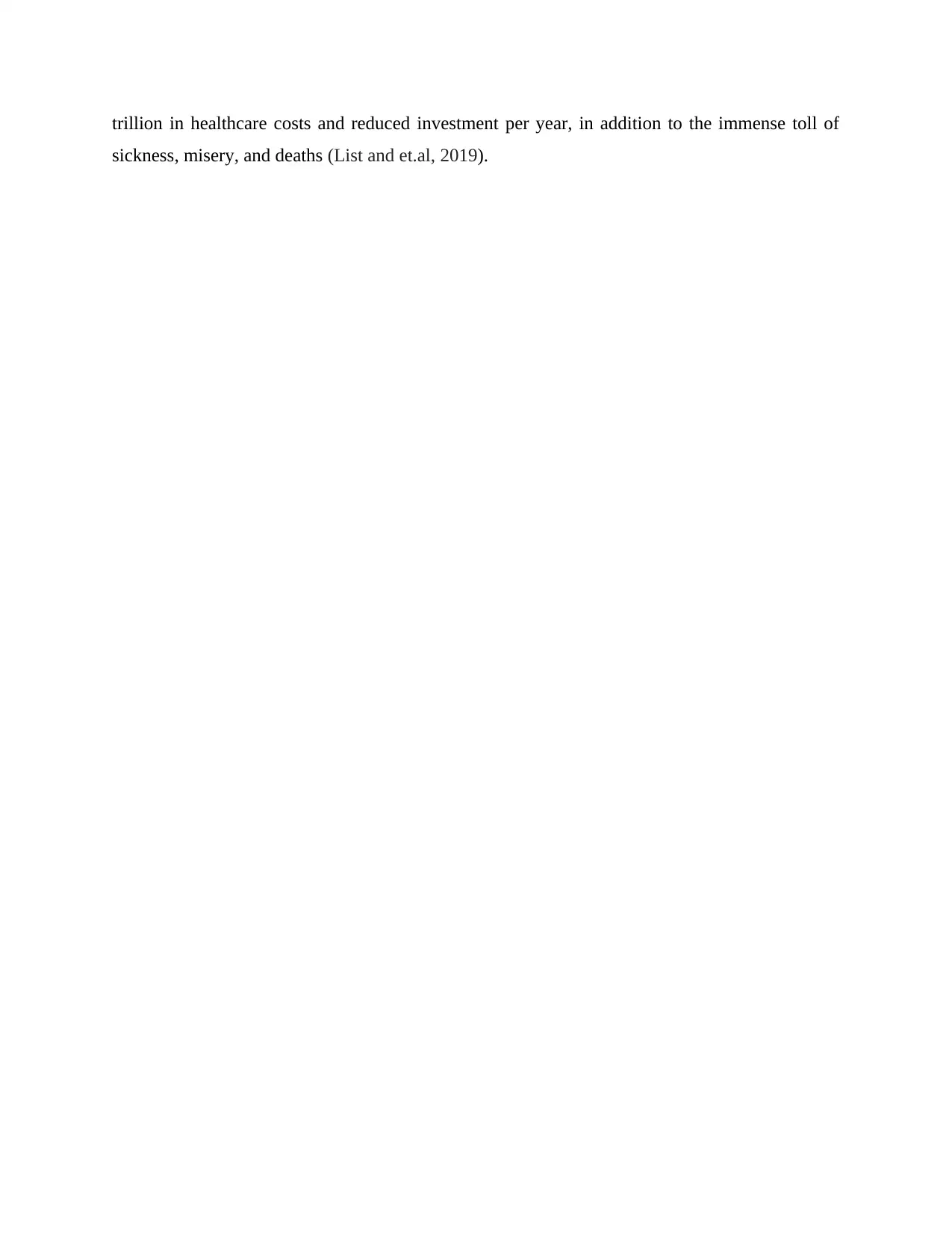
trillion in healthcare costs and reduced investment per year, in addition to the immense toll of
sickness, misery, and deaths (List and et.al, 2019).
sickness, misery, and deaths (List and et.al, 2019).
⊘ This is a preview!⊘
Do you want full access?
Subscribe today to unlock all pages.

Trusted by 1+ million students worldwide
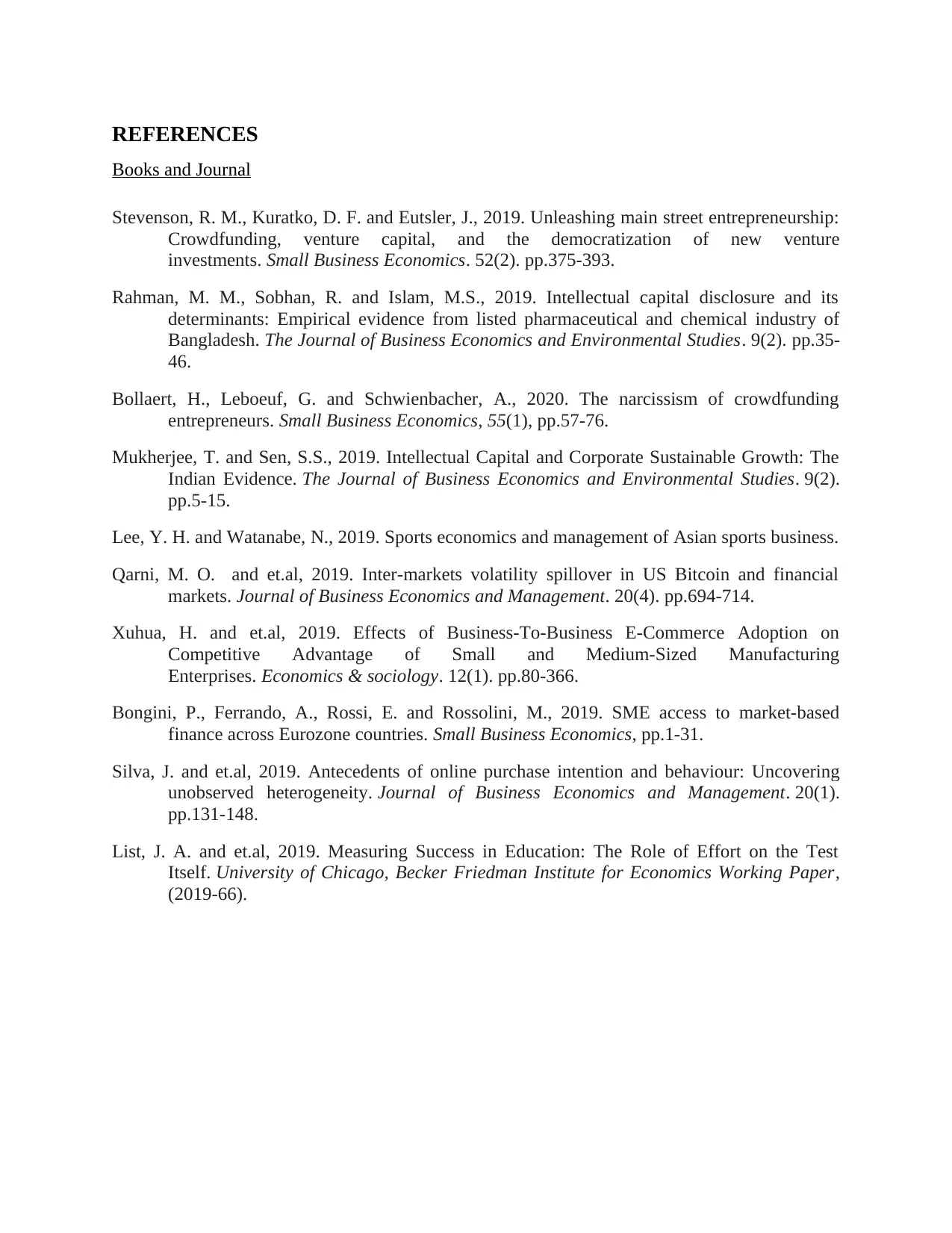
REFERENCES
Books and Journal
Stevenson, R. M., Kuratko, D. F. and Eutsler, J., 2019. Unleashing main street entrepreneurship:
Crowdfunding, venture capital, and the democratization of new venture
investments. Small Business Economics. 52(2). pp.375-393.
Rahman, M. M., Sobhan, R. and Islam, M.S., 2019. Intellectual capital disclosure and its
determinants: Empirical evidence from listed pharmaceutical and chemical industry of
Bangladesh. The Journal of Business Economics and Environmental Studies. 9(2). pp.35-
46.
Bollaert, H., Leboeuf, G. and Schwienbacher, A., 2020. The narcissism of crowdfunding
entrepreneurs. Small Business Economics, 55(1), pp.57-76.
Mukherjee, T. and Sen, S.S., 2019. Intellectual Capital and Corporate Sustainable Growth: The
Indian Evidence. The Journal of Business Economics and Environmental Studies. 9(2).
pp.5-15.
Lee, Y. H. and Watanabe, N., 2019. Sports economics and management of Asian sports business.
Qarni, M. O. and et.al, 2019. Inter-markets volatility spillover in US Bitcoin and financial
markets. Journal of Business Economics and Management. 20(4). pp.694-714.
Xuhua, H. and et.al, 2019. Effects of Business-To-Business E-Commerce Adoption on
Competitive Advantage of Small and Medium-Sized Manufacturing
Enterprises. Economics & sociology. 12(1). pp.80-366.
Bongini, P., Ferrando, A., Rossi, E. and Rossolini, M., 2019. SME access to market-based
finance across Eurozone countries. Small Business Economics, pp.1-31.
Silva, J. and et.al, 2019. Antecedents of online purchase intention and behaviour: Uncovering
unobserved heterogeneity. Journal of Business Economics and Management. 20(1).
pp.131-148.
List, J. A. and et.al, 2019. Measuring Success in Education: The Role of Effort on the Test
Itself. University of Chicago, Becker Friedman Institute for Economics Working Paper,
(2019-66).
Books and Journal
Stevenson, R. M., Kuratko, D. F. and Eutsler, J., 2019. Unleashing main street entrepreneurship:
Crowdfunding, venture capital, and the democratization of new venture
investments. Small Business Economics. 52(2). pp.375-393.
Rahman, M. M., Sobhan, R. and Islam, M.S., 2019. Intellectual capital disclosure and its
determinants: Empirical evidence from listed pharmaceutical and chemical industry of
Bangladesh. The Journal of Business Economics and Environmental Studies. 9(2). pp.35-
46.
Bollaert, H., Leboeuf, G. and Schwienbacher, A., 2020. The narcissism of crowdfunding
entrepreneurs. Small Business Economics, 55(1), pp.57-76.
Mukherjee, T. and Sen, S.S., 2019. Intellectual Capital and Corporate Sustainable Growth: The
Indian Evidence. The Journal of Business Economics and Environmental Studies. 9(2).
pp.5-15.
Lee, Y. H. and Watanabe, N., 2019. Sports economics and management of Asian sports business.
Qarni, M. O. and et.al, 2019. Inter-markets volatility spillover in US Bitcoin and financial
markets. Journal of Business Economics and Management. 20(4). pp.694-714.
Xuhua, H. and et.al, 2019. Effects of Business-To-Business E-Commerce Adoption on
Competitive Advantage of Small and Medium-Sized Manufacturing
Enterprises. Economics & sociology. 12(1). pp.80-366.
Bongini, P., Ferrando, A., Rossi, E. and Rossolini, M., 2019. SME access to market-based
finance across Eurozone countries. Small Business Economics, pp.1-31.
Silva, J. and et.al, 2019. Antecedents of online purchase intention and behaviour: Uncovering
unobserved heterogeneity. Journal of Business Economics and Management. 20(1).
pp.131-148.
List, J. A. and et.al, 2019. Measuring Success in Education: The Role of Effort on the Test
Itself. University of Chicago, Becker Friedman Institute for Economics Working Paper,
(2019-66).
1 out of 10
Related Documents
Your All-in-One AI-Powered Toolkit for Academic Success.
+13062052269
info@desklib.com
Available 24*7 on WhatsApp / Email
![[object Object]](/_next/static/media/star-bottom.7253800d.svg)
Unlock your academic potential
Copyright © 2020–2025 A2Z Services. All Rights Reserved. Developed and managed by ZUCOL.




